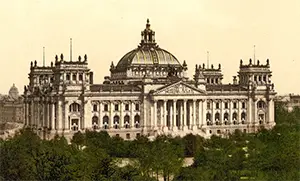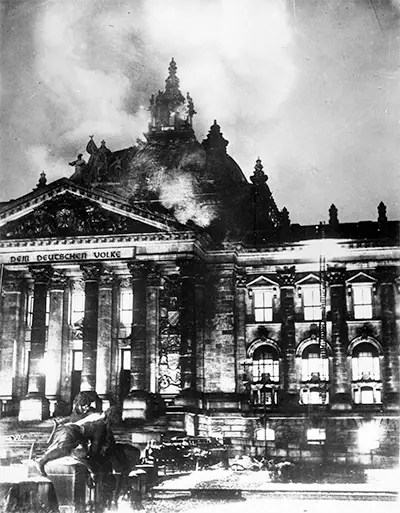The Reichstag Fire
The Reichstag fire severely damaged the house of the German legislature in 1933 and became a pretext for the Nazi assumption of power. 
The building, the result of an architecture contest, opened in 1894, to house the Imperial Diet. Then-Kaiser Wilhelm I laid the foundation stone in 1884, and construction took a decade to complete. By that time, a new Kaiser, Wilhelm II, had taken over. That leader added in the midst of the German Revolution, in the waning days of World War I, and Philipp Scheidemann had proclaimed the advent of a republic from a Reichstag balcony. The country's main legislative body, also called the Reichstag, met in the building for nearly four decades. 
On Feb. 27, 1933, the building burned to the ground. Investigations determined arson to be the cause of the fire and had as their prime suspect Marinus van der Lubbe of the Netherlands, a known Communist sympathizer who was found inside the building during the fire. Investigators claimed that he confessed to having set the fire, and he was duly arrested. Less than a month before, German President Paul von Hindenburg had named a new Chancellor, Adolf Hitler of the National Socialist German Workers' Party, more well-known as the Nazi Party. That party had received the most votes in the 1932 elections, and Hitler argued that that gave him the responsibility to act as Chancellor. Hindenburg reluctantly agreed. Quickly declaring that Communist revolutionaries had started the fire, Hindenburg, at Hitler's urging, signed the Emergency Decree for the Protection of the German People (also known as the Reichstag Fire Decree), which, under the auspices of the declaration of a State of Emergency, wiped away the German people's personal, political, and property rights. (Article 48 of the Weimar Constitution allowed for such an activity.) Hitler also called for new elections for the Reichstag. Those duly took place, on March 5. The Fire Decree had given police broad powers to arrest any and all anti-government suspects; German police duly arrested the leaders of the German Communist Party, and so that party's showing in the new elections was very low. The Reichstag, without its traditional place of business, met at the Kroll Opera House in Berlin. Even though the Nazi Party still had no majority, they were the largest party represented in the Reichstag, having gained 44 percent of the vote, and so used their influence to convince the needed extra members to pass the Enabling Act. The Act, passed on March 23, transferred all legislative powers to the Reich Cabinet. The vote, in fact, was an overwhelming 444 in favor to 94 opposed. Thus, the Reichstag gave up its powers. Meanwhile, arson suspects went on trial, in Leipzig. Van der Lubbe was found guilty of treason and then executed. Prosecutors targeted four Communists: German Communist Party Ernst Torgler and Bulgarian Communists Georgi Dimitrov, Simon Popov, and Vassili Tanevy; all won acquittal because of a lack of evidence tying them to the crime. One other result of the hysteria that grew out of the Reichstag Fire was the development of concentration camps, to hold (at first) political opponents. The first, Dachau, opened on March 20, 1933. |
|
Social Studies for Kids
copyright 2002–2024
David White





